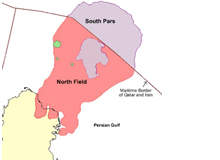
The 1,880km Iran-Pakistan pipeline is being built to carry natural gas from Iran’s South Pars field to Baluchistan and Sindh provinces in Pakistan.
The $7.5bn pipeline will carry 750 million cubic feet of natural gas per day. It is expected to be operational by 2014.
Iran has allotted 50% capacity of the pipeline to Pakistan.The new pipeline is vital for Pakistan to satisfy its growing energy needs.
Pakistan has been suffering from severe electricity shortages due to a lack of gas supplies. Pakistan’s electricity generation capacity is currently 16,500MW.
To satisfy the growing demand, it will require an additional 4,000 to 5,000MW. The new pipeline is expected to meet this surplus demand and help save $1bn on oil imports annually.
Delays for the Iran-Pakistan pipeline
The project, earlier known as the Peace Pipeline, was originally proposed in the 1990s and included a 600km extension to India. Since the pipeline route passes through conflicted areas such as Baluchistan, India withdrew from the project in 2009, citing concerns with gas pricing and security of the pipeline.
Pressure from the US was also considered as one of the reasons for India’s withdrawal. The US government has been trying to isolate Iran economically.
The new pipeline project goes against these efforts. Despite concerns from the US, Pakistan decided to build the pipeline to address its growing energy problems.
In June 2010, Pakistan and Iran signed an agreement to go ahead with the project. The agreement was signed between the Iranian Gas Export Company and Pakistan’s Inter State Gas Systems (ISGS). According to the agreement, Iran will supply gas to Pakistan for a period of 20 years with a five-year grace period.
Construction and infrastructure of the international pipeline
Iran and Pakistan will be individually responsible for constructing the sections of pipeline passing through their own territory.
Construction of Iranian section of the pipeline has been completed. The Iranian section of the pipeline has a diameter of 56in.
In February 2013, Pakistan’s Inter-State Gas Systems (ISGS) and Iran’s Tadbir Energy Costar Iranian signed an agreement for starting the construction of the Pakistani segment of the pipeline. This segment is expected to have a diameter of 42in and length of 781km.
A special purpose vehicle named PipeCo will be used to construct and operate the Pakistani section of the pipeline.
Pakistan is expected to complete the section by December 2014. Failure to complete the project on time will result in a penalty for Pakistan.
A consortium consisting of Sui Northern Gas Pipeline Limited (SNGPL), Sui Southern Gas Company Limited (SSGCL) and Frontier Works Organisation (FWO) are responsible for the engineering & construction of the IPGP.
SSGCL & SNGPL will be involved in the mechanical works related to the project where as FWO will carry out the civil works for the pipeline from Gabd to Nawabshah inside Pakistan’s territory.
Iran-Pakistan natural gas pipeline route
The Iranian section of the pipeline is 1,100km long. It starts from the Pars energy economic zone to Iranshahr and to Bushehr.
It then passes through Fars, Kerman, Hormozghan and sistan – Baluchistan.
The Pakistani portion of the pipeline will be approximately 780km long from Pakistan border to Nawabshah.
About 665km of the section will run through Balochistan and 115km through Sindh.
The new pipeline will carry gas from the South Pars field which is the world’s biggest natural gas field.
The field is estimated to contain 14 trillion cubic metres of natural gas and 18 billion barrels of condensates. During 2009-2010, the field produced 59 billion cubic metres of gas.
Contractors involved in the Iran-Pakistan project
Germany-based consultancy firm ILF was awarded a $55m contract to carry out the route survey of the Pakistani portion of the pipeline. ILF carried out the survey in association with National Engineering Services of Pakistan (NESPAK). The two companies were also involved in the front end engineering design and feasibility study of the project.


